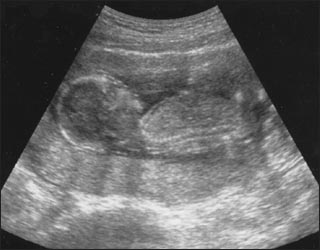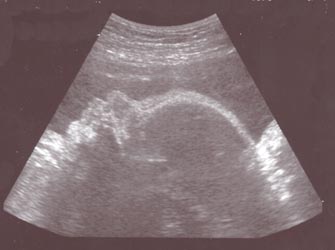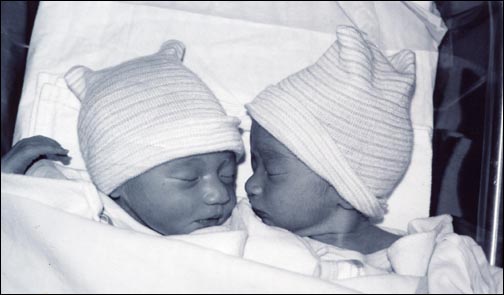태아들, 신생아들, 0~6개월 영아들의 정상 수면 패턴, Normal sleep patterns in fetus, newborns and 1~6 month age infants

사진 163. 임신 20주 된 태아가 자궁 속에서 자고 있다.
Copyright ⓒ 2012 John Sangwon Lee, MD, FAAP

사진 164. 임신 36주 된 태아가 자궁 속에서 자고 있다.
Copyright ⓒ 2012 John Sangwon Lee, MD, FAAP
1. 생물시계와 설카디안 리듬
Biological clock and Circardian rhythm
- 시상하부가 뇌 속에 있다.
- 시상하부 부위에 시각신경교차가 있고 시각신경 교차의 바로 위에 생물시계(Biological clock)가 정상적으로 있다.
- 사람의 잠자는 시간과 깨어 있는 한 주기는(Sleep and wake cycle) 약 24시간이다.
- 자는 시간과 깨어 있는 24시간 주기를
- 설카디안 리듬(Circardian rhythm),
- 하루 주기 리듬,
- 24시간 주기 리듬
- 또는 24시간 리듬이라고 한다.
- 각 자의 설카디안 리듬은 유전자 구성(Genetic make-up)에 의해서 이미 결정되어 있고 사는 지역의 밤과 낮 시간에 맞추어 간다.
- 생물시계가 설카디안 리듬을 조절한다. 그 생물시계는 살고 있는 지역의 밤낮주기에 따라 조절된다.
- “생물 시계”는 주위 환경에서 일어나는 여러 가지의 신호에 따라 설카디안 리듬을 조절한다.
- 한국에서 미국으로 온 사람의 생물시계 리듬은 미국지역의 설카디안 리듬에 따라 정해지기 시작한다.
- 한국 설카디안 리듬은 미국 지역 설카디안 리듬으로 갑자기 완전히 바꿔지지 않는다.
- 그런 이유로 미국 여행을 간 사람이 처음 며칠 동안은 미국에서 낮에 자고 밤에는 깨어 있는 현상이 며칠 동안 생길 수 있다.
- 이런 현상을 제트 래그라고 한다. 그 후 더 오래 살고 있는 미 지역의 낮 밤 주기에 따라 설카디안 리듬이 결정된다.
- “생물 시계”는 자궁 속 태아기 때부터 똑딱 똑딱 가고 있다.
- 엄마의 자궁 속 태아들은 엄마의 설카디안 리듬에 따라 밤과 낮 주기를 확실히 구분해서 잠자고 깨어 있지는 않지만 태어나자마자 신생아들은 그들의 사는 곳의 설카디안 리듬에 맞춰 점차로 자고 깨고 활동 하기시작 한다. 생후 4~6개월 걸려 사는 곳의 설카디안 리듬에 거의 확실하게 맞춰간다
- 모체에서 분비되는 멜라토닌(Melatonin)이나, 다른 종류의 모체 호르몬의 혈중 농도에 따라 태아의 뇌 속에 있는 “생물 시계”가 영향을 받아 태아의 “설카디안 리듬”이 변화되고 그로 인해 태아에게도 밤과 낮 주기가 어느 정도 생긴다.
- 태아의 설카디안 리듬은 임신 36~38주경부터 어느 정도 더 확실하게 정해지기 시작해서 설카디안 리듬에 따라 태아들은 자고 깨고 활동하는 시간이 어느 정도 정해지기 시작한다.
- 임신 36~38주경부터, 태아 수면 설카디안 리듬에 따라 대부분 태아들에게 다음 4가지의 수면과 활동 기간이 자궁 내에서 생긴다.
- 아주 조용히 잠자는 시간
- 적극적으로 잠자는 시간
- 깨서 적극적으로 활동하는 시간
- 깨서 조용히 있는 시간이 태아에게 생긴다.
- 이렇게 태아가 자궁 속에서 설카디안 리듬에 따라 하루 24시간을 보낸다고 한다.
- 24시간 태아 설카디안 리듬 중
- 40%의 기간 동안은 태아가 활동 하지 않고 아주 조용히 잠자고,
- 42%의 기간 동안은 아주 적극적으로 잠자는 데 시간을 보내고,
- 약 10%의 기간 동안은 몸을 움직이면서 깨서 활동하고,
- 약 7~8%의 기간을 깨서 조용히 쉰다고 한다.
- 설카디안 리듬은 체내 “생물 시계”에 의해서 조절될 뿐만 아니라 신체 내 신진대사, 혈압의 상승하강, 체온의 변화와 호르몬의 혈 중 농도 등에 따라서도 조절된다.
- 이렇게 해서 밤과 낮의 주기 즉 설카디안 리듬이 태아 적부터 성립되고 그 리듬에 따라 낮에는 주로 활동하고 밤에는 주로 자는 현상이 인간에게 생긴다.

사진 165. 갓 태어난 신생아들에게 하루 24시간 밤낮 주기(설카디안 리듬)가 일정하게 정해지지 않아 아무 때나 자고 깨는 것이 보통이다. 생후 4~ 6개월 정도 되면 하루 24시간 밤낮 주기가 어느 정도 확실해지고 밤과 낮 주기가 어느 정도로 확실히 정해지는 것이 보통이다.
Copyright ⓒ 2012 John Sangwon Lee, MD, FAAP
- 이렇게 하루의 밤과 낮이 정해져 있는 패턴을 설카디안 리듬(Circadian rhythms)이라고 이미 언급했다.
- 설카디안 리듬을 “24시간 리듬” 또는 “24시간 밤낮 주기”라고도 한다.
- 사는 지역과 나라에 따라 “24시간 밤낮주기”가 다르다.
- 24시간 밤낮 주기에 따라 밤에는 자고 낮에는 깨어있는 주기가 다르게 결정된다.
- 예를 들어, 미국에서 살던 사람이 한국을 방문했을 때 처음 며칠 동안 그의 “생물 시계”가 한국의 “24 시간 밤과 낮 주기” 즉 설카디안 리듬에 맞지 않아 제트 랙이 생긴다.
- 그 후 며칠 동안 한국 같은 지역에서 계속 지내면, “생물 시계”는 그 지방 시간에 해당되는 “24시간 밤과 낮 주기” 즉 설카디안 리듬에 따라 간다.
- 생후 0~6주까지, 대부분 아기들은 태아 적부터 가지고 있던 “24시간 밤낮주기”에 따라 주로 잠자고 깨고 먹고 논다.
- 다시 설명하면, 생후 0~6주 된 아기들 대부분은 “24 시간 밤과 낮 주기”에 따라 먹고 자고 놀지 않는다.
- 생후 6주 이후부터 “24시간 밤과 낮 주기”가 조금씩 서서히 형성되기 시작해서 생후 4~6개월 정도 되면 “24시간 밤과 낮 주기”가 살고 있는 그 지역과 부모 형제들의 일상 삶의 “24시간 밤과 낮 주기”와 거의 같아진다.
- 생후 6개월부터는 “24시간 밤과 낮 주기”는 점점 더 확실해져서, 생후 6개월 이후 대부분의 영아들은 부모 형제들의 24시간 밤과 낮 주기에 따라 밤에는 자고, 부모 형제들이 깨어 먹고 활동하는 낮 주기에 맞춰 깨어서 먹고 노는 ” 24시간 밤과 낮 주기”가 확실히 정해진다.
- 여기서, 왜 태아가 얼마 동안은 막 놀고 그 다음은 얼마 동안은 조용히 있는 이유도 이해할 수 있고 신생아들이나 생후 6주 이전 영아들의 일부는 “하루 24시간 밤과 낮 기간” 중 아무 때나 깨고 자는 이유를 이해할 수 있고 생후 6개월 이전 영아들의 일부는 밤낮 가리지 않고 먹고 자고 하는 지 알 수 있다.
- 생후 6개월 이후 점점 더 성장 발육하면 그들의 수면 패턴이 부모들의 수면 훈련에 따라간다.
- 이런 정상 수면 패턴을 알면 자녀 양육에 도움이 될 것이다.
Copyright ⓒ 2014 John Sangwon Lee, MD., FAAP
Normal sleep patterns in the fetus, newborns and 1-6 month age infants 태아들, 신생아들, 0~6개월 영아들의 정상 수면 패턴

Picture 163. A 20-week-old fetus is sleeping in the womb. Copyright ⓒ 2012 John Sangwon Lee, MD, FAAP

Picture 164. A 36-week-old fetus is sleeping in the womb. Copyright ⓒ 2012 John Sangwon Lee, MD, FAAP
1. Biological Clock and Circadian Rhythm
- Biological clock and Circadian rhythm The hypothalamus is in the brain.
- There is a visual nerve intersection in the hypothalamus and a Biological clock is normally just above the visual nerve intersection.
- A person’s sleep and wake cycle is about 24 hours.
The time to sleep and the 24-hour awake cycle
- Circadian rhythm,
- 24-hour cycle rhythm
- Or it is called a 24-hour rhythm.
- Each person’s Circadian rhythm is already determined by genetic make-up and matches the night and daytime of the region where he lives.
- The biological clock regulates the Circadian rhythm.
- The biological clock is adjusted according to the day and night cycle of the area where you live.
- The “biological clock” regulates the Circadian rhythm according to a number of signals occurring in the surrounding environment.
- The bio clock rhythm of people who came to the United States from Korea began to be determined according to the Circadian rhythms of the United States.
- The Korean Circadian rhythm does not suddenly change completely to the local Circadian rhythm in the United States.
- For that reason, a person who travels to the United States may sleep in the United States during the first few days and stay awake at night for several days. This phenomenon is called jet lag. After that, the Circadian rhythm is determined by the day and night cycles in the U.S. where they live longer.
- The “biological clock” has been ticking since prenatal in the womb.
- The fetuses in the mother’s womb do not sleep and awake according to the mother’s Circadian rhythm by separating the night and day cycles, but as soon as they are born, the newborns gradually sleep and wake up to the Sulcardian rhythm of where they live. It takes 4 to 6 months of age and almost certainly matches the Sulcardian rhythm of where you live. Depending on the blood concentration of melatonin or other types of maternal hormones secreted by the mother, the “biological clock” in the fetus’s brain is affected, causing the fetus’s “Circadian rhythm” to change.
- Some daytime cycles occur.
- The Circadian rhythm of the fetus begins to be determined more clearly from 36 to 38 weeks of pregnancy, and according to the Circadian rhythm,
- the time for the fetus to sleep,
- wake,
- and act begins to be determined to some extent.
- From around 36 to 38 weeks of pregnancy,
- most of the fetuses have the following four sleep and active periods in the uterus according to the fetal sleep Circadian rhythm.
- Time to sleep very quietly Active sleeping time Time to wake up and be active The time to be awake and quiet is given to the fetus.
- It is said that the fetus spends 24 hours a day in the womb according to the Circadian rhythm.
- 24-hour fetal Circadian rhythm
- For 40% of the time,
- the fetus is inactive and sleeps very quietly,
- 42% of the time spent sleeping very actively,
- For about 10% of the time, the body is active while awakening,
- It is said that about 7~8% of the period is broken and quietly rested. Circadian rhythm is controlled not only by the body’s “biological clock”, but also by metabolism in the body, the rise and fall of blood pressure, changes in body temperature, and the concentration of hormones in the blood. In this way, the night and day cycle, that is, the Circadian rhythm is established from the fetus, and according to the rhythm, humans are mainly active during the day and sleep mainly at night.

Picture 165. Newborn babies usually sleep and wake up at any time because the 24-hour day and night cycle (Circadian rhythm) is not fixed.
- At about 4-6 months of age, it is common for the 24 hours a day and night and day cycles to become certain to some extent, and to determine the night and day cycles to some extent. Copyright ⓒ 2012 John Sangwon Lee, MD, FAAP
- The pattern in which the night and day of the day are determined is already mentioned as Circadian rhythms. Sulcardian rhythm is also referred to as “24-hour rhythm” or “24 hour day and night cycle.
- ” The “24 hours day and night cycle” is different depending on the region and country where you live.
- Depending on the 24-hour day and night cycle, sleeping at night and waking up during the day are determined differently.
- For example, when a person living in the United States visited Korea in the first few days, his “biological clock” did not match the Korean “24 hour night and day cycle”, or Sulcardian rhythm, resulting in a jet rack.
- If you continue to live in an area like Korea for a few days after that, the “Bio-Clock” follows the “24 hour night and day cycle” corresponding to that local time, or circadian rhythm. From 0 to 6 weeks of age, most babies usually sleep, wake up, eat and play according to the “24 hours night and day cycle” they have since fetus.
- In other words, most babies aged 0-6 weeks do not eat, sleep and play according to the “24 hour night and day cycle”.
- From 6 weeks after birth, the “24 hour night and day cycle” gradually begins to form, and at about 4-6 months of age, the area where the “24 hour night and day cycle” lives and the “24 hours of the daily life of parents and siblings”
- It becomes almost the same as the “night and day cycle”. From 6 months of age, the “24-hour night and day cycle” becomes more and more clear, and after 6 months of age, most infants sleep at night according to their parents and siblings’ 24-hour night and day cycle, and the day cycle in which parents and siblings wake up and be active.
- The “24-hour night and day cycle” is definitely decided. Here, you can also understand why the fetus is just playing for some time and then quiet for some time, and why some newborns and infants before 6 weeks of age wake up and sleep at any time during the “24 hours a day-night and day period”.
- You can see if some of the infants before 6 months of age eat and sleep day or night. As they grow and develop more and more after 6 months of age, their sleep patterns follow their parents’ sleep training.
- Knowing these normal sleep patterns will help you raise your child. Copyright ⓒ 2014 John Sangwon Lee, MD., FAAP
“부모도 반의사가 되어야 한다”-본 사이트의 내용은 여러분들의 의사로부터 얻은 정보와 진료를 대신할 수 없습니다.
“The information contained in this publication should not be used as a substitute for the medical care and advice of your doctor. There may be variations in treatment that your doctor may recommend based on individual facts and circumstances.
“Parental education is the best medicine.“